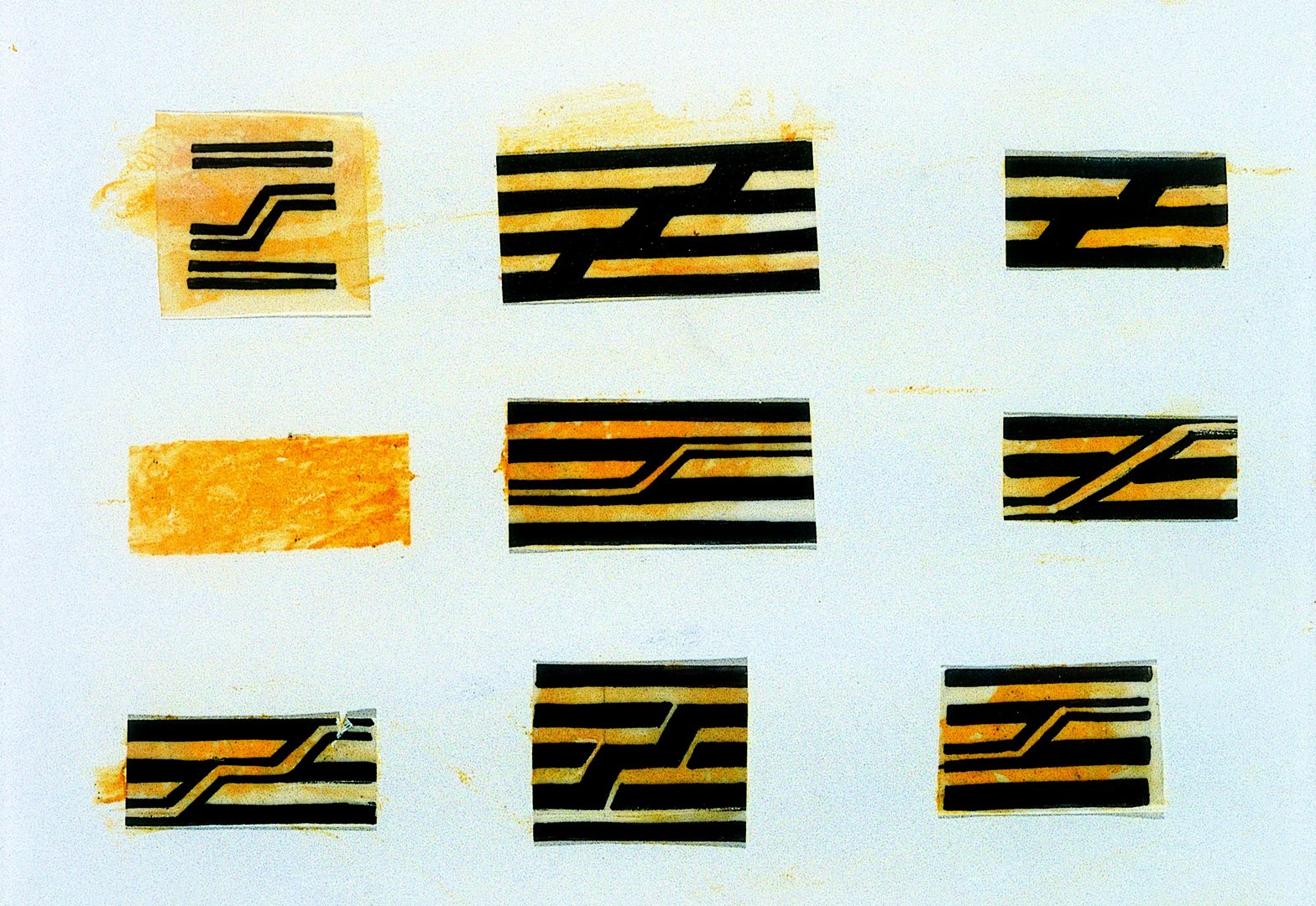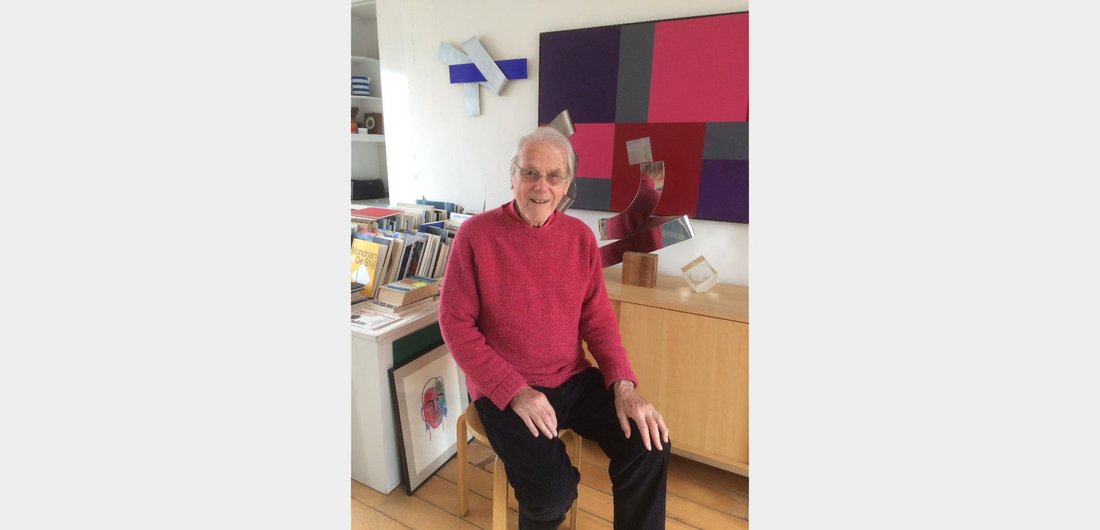
40 years after, the secrets of a now-iconic logo
One of the world's most recognisable logos took shape on a corner of an embossed tablecloth. Graphic designer Jean Widmer sketched it with a few pencil strokes while seated on the terrace of a bistro facing the Centre Pompidou, which was undergoing works at the time. Six black stripes crossed by two zigzags, inspired by the famous "caterpillar" – the escalator that rises to the floors. The interplay of fullness and emptiness. No contours. A veritable work drawing. Now in his 90s, the Swiss artist remembers: "It's the fastest logo I designed in my whole career, I already had it in mind." Widmer's stroke of genius? Based on the structure of the building, it sums up its missions: multi-disciplinarity and openness. Since that day in 1977, Widmer's logo has been all around the world, passing through the decades without ever losing its graphic force.
It's the fastest logo I designed in my whole career, I already had it in mind.
Jean Widmer
In October 2019, the Centre Pompidou even decided to return to the original version with five black stripes instead of six. Lighter and less massive, this was the designer's first proposal. A change in continuity, but most of all a form of homage to the creator's first vision. At the time, Widmer had to abide by the demands of the decision-makers who insisted that the logo have as many floors as the building itself.
Although Widmer's creation has now become an integral part of the visual identity of the Centre Pompidou, this was not a foregone conclusion. Culture was not yet a marketing commodity in the 1970s, and having a logo seemed far too much like advertising. As early as 1974, when the building works were underway, a call for tender was nonetheless put out for the "brand image" of the Centre Pompidou. This original request attracted some of the greatest talents of the day, such as the Belgian graphic designer Michel Olyff, Polish artist Roman Cieslewicz, Britain’s Henri Kay Henrion, Swiss typographer Adrian Frutiger, Italian designer Massimo Vignelli and Swiss Jean Widmer. The fifteen participants worked on everything that would make up the visual identity of the Centre Pompidou, in concertation with the building's architects, Renzo Piano and Richard Rogers. The roadmap was clear: they had to think "unity in diversity" and invent "a communicating machine".
The jury consisted of the presidents of the different components of the Centre Pompidou (including Pierre Boulez from the Ircam, the Institute for Research and Coordination in Acoustics/Music) and was chaired by Willem Sandberg, typographer and curator at the Stedelijk Museum in Amsterdam, a worldwide reference in contemporary museography. Knowing that the jury would meet around a gigantic meeting table, Widmer, his associate Ernst Hiestand and the team from the VDA (Visual Design Association) agency decided to opt for an A3 format with a Japanese-style leporello concertina presentation – a long strip of paper nearly twenty metres long! Their graphic proposal was fairly simple: a colour code for each department in the Centre Pompidou (the graphic arts in red, the Industrial Creation Centre in blue, the Library in green, the Ircam in violet, and common areas in yellow). Widmer: "I got a letter from Boulez one day, complaining about the colour defined for the Ircam. He found it "hideous and crepuscular". So I showed him a Pantone colour chart with 1500 colours and explained to him that the colours of the departments were distributed at equal distances around the colour wheel. Having reviewed the colour chart, including the red that was already reserved, I then suggested purple to him… and he agreed to that! I announced the news to Pontus Hultén, the President at the time, who responded "But Widmer, it's the same colour as before?" “Well, I suppose it is!" Jean Widmer is certainly wily. Another new idea from the designer was that the information panels should be vertical. Which would give Pontus Hultén a stiff neck. As a joke, he took to the habit of greeting Widmer with his head inclined and stiff-lipped (but went on to find the idea brilliant).
After due deliberation, the project led by Widmer hit the jackpot. However, there was still no question of creating a logo at the time. Widmer was against it: "Our position was clear. We believed that a centre for art and culture was neither a bank nor an airport. Moreover, a logotype could go out of fashion or be dependent on a political power". But three months from the inauguration, scheduled for late January 1977, Secretary General Claude Mollard had an idea. The Centre Pompidou should be endowed with a unifying visual element – even if it rubbed some people the wrong way. Widmer recounts: "Mollard stormed in and told me: "we have to have a logo, it's urgent and if you don't do it, we'll go elsewhere". I answered "OK, I'll do it, but it'll be the façade with the escalator. "He loved the idea! I presented the two logos at the same time, the one with five stripes and the one with six. They wanted me to draw a black frame around it but at that point I said, "it's out of the question!" I finally gave in on the six stripes, although I found it less forceful". The recent return to the original necessarily delighted its creator: "the five-stripe version is much more effective!"
Mollard stormed in and told me: "we have to have a logo, it's urgent and if you don't do it, we'll go elsewhere". I answered "OK, I'll do it, but it'll be the façade with the escalator. "He loved the idea! I presented the two logos at the same time, the one with five stripes and the one with six. They wanted me to draw a black frame around it but at that point I said, "it's out of the question!" I finally gave in on the six stripes, although I found it less forceful.
Jean Widmer
Although it is now intrinsically associated with the Centre Pompidou, this design icon very nearly disappeared at the turn of the millennium. In the late 1990s the building had to undergo a necessary clean-up operation. And the Centre Pompidou closed its doors to the public. Jean-Jacques Aillagon, president of the institution at the time, wanted to avail of this opportunity to rethink its visual identity. Renzo Piano who was directing the renovation work, called on Swiss Ruedi Baur, incidentally a friend of Widmer. Baur made various proposals, including one for multi-coloured and multi-lingual stencils. The press and the public were upset to see the famous logo fall from grace. The staff distributed leaflets. As Jean Widmer explains, "My friends from the International Graphic Alliance, which brings together the greatest names in the discipline, notably Pierre Bernard, from the Grapus workshop, wrote to the Minister for Culture, Catherine Trautmann. She decided to list it, in the same way that a monument is listed". The logo was thus saved at the last moment. It was restored to its full role in 2019: that of a masterpiece of modern times, pure and visionary. ◼
Related articles
Logo du Centre Pompidou, ébauches
Photo © J. Widmer





